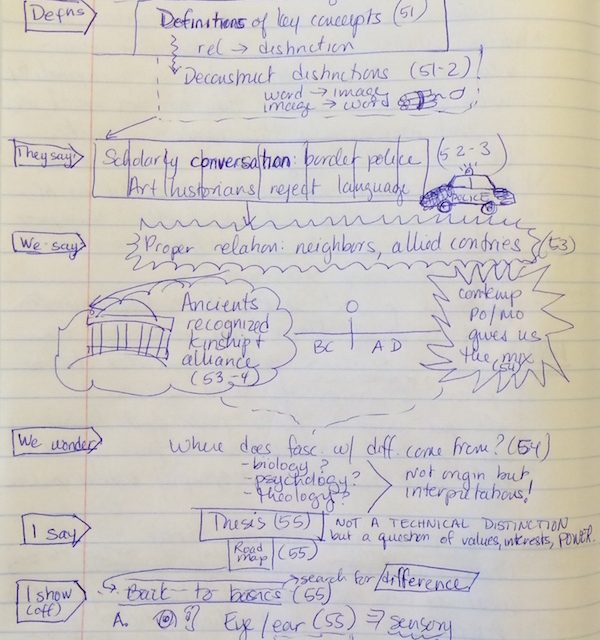Gamestorming your hybrid projects

In the mindfullness/meditation workshop on Wednesday, Kristen Eshleman guided us through some “gamestorming” exercises that might be helpful for you as you dig into your hybrid projects. Gamestorming is a “set of tools for rule breakers, innovators and changemakers” developed to stimulate creative problem-solving in the business world. The principles and practices can also be applied to the academic world. We’ve actually been using this process in the development of the hybrid… Read More
How it all fits together

In your midterm evaluations, some of you raised questions about how the different units of the course fit together. We can certainly do more to highlight the connections during the second half of the semester. I also thought it might help to offer a narrative explaining the logic behind the Calendar. My hope is that when you read this “story,” you’ll gain a clearer “picture” of how I plotted the course design… Read More
Relations between Words & Images

Thanks, Graham, for your expert sketch-noting about the possible relationships between words & images. If anyone took notes of our definitions of “word” and “image,” please take a photo of your notes and add it to this post, or transcribe the notes here. Here are the definitions I came up with, but you had good additions, elaborations, and complications: WORDS: Units of characters that operate in verbal language system to convey meaning;… Read More
What’s Going On In This Picture?

The digital New York Times has been upping its image-text game ever since it published the groundbreaking multimedia story, “Snow Fall,” by John Branch. Incidentally, “Snow Fall” is the first digital narrative that made me believe I actually might be able to read online—really read, in the fully immersive way I get absorbed in a book. It actually made me think that a well designed digital narrative could not just be as… Read More
Sketch notes on Mitchell’s “What Is an Image?”

These sketch notes attempt to extract useful principles and concepts from W. J. T. Mitchell’s “What Is an Image?”—a chapter that surveys various definitions and theories of images and deconstructs them to show that all images (like words) operate within a system of language. Mitchell does not claim that words and images are exactly alike or operate in the same ways, but he insists that the divisions between them are not hard… Read More
Doodle SSR: Mitchell’s Word & Image

I tried doodling an SSR of Mitchell’s essay “Word & Image” and now I understand it like never before. You have the option of doing your SSR on McKenzie in Doodle form, as long as you upload a clear, cropped, downsized photo that shows you’ve analyzed the structure of the entire argument. The photo should be big enough that when we click on it, we can read it, but not so huge… Read More
Hourly Comics Day

Thanks to Jenna for alerting us to the tradition of Hourly Comics Day: The gist of it is that you draw a short comic for every hour you’re awake about whatever you did during that hour. – Jenna Rules for us: No stick people. Build characters out of simple shapes: circles, characters, rectangles. Minimal features, rudimentary limbs are ok as is basic pattern on clothing. Comics do not have to be professional… Read More
Such Smart. Many funny.

Samantha and Cordelia’s post on the “successful black man” memes made me want to investigate the genre. With help from Dr. Kohout, I came across this article by Gretchen McCulloch, “A Linguist Explains the Grammar of Doge. Wow.” Smart and funny, the article makes me wonder if someone could do a comparable analysis of the images included in these memes. Do “doge” images follow similar rules or violate photographic conventions? Do images have… Read More
Reading Race, Seeing Double

Today’s class touched on so many important issues about how we see race—and see it differently depending on our experiences and ineluctable positions within a racialized social order. I tied your ideas to some classic American texts that you may not have read. Following up on our in-class activities, in this post, I draw specific lines of connections between your ideas and those classic texts. In Souls of Black Folk (1903), W…. Read More
